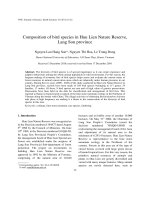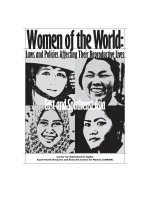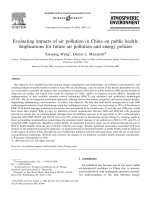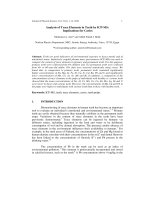The impacts of introductions and stocking of exotic species in the Mekong Basin and policies for their control
Bạn đang xem bản rút gọn của tài liệu. Xem và tải ngay bản đầy đủ của tài liệu tại đây (22.58 MB, 60 trang )
The Impacts of Introductions and Stocking of Exotic Species in the Mekong Basin and Policies for Their Control
The Impacts of Introductions and Stocking of Exotic Species in the Mekong Basin and Policies for Their Control
The Impacts of Introductions and Stocking of Exotic Species in the Mekong Basin and Policies for Their Control
THE IMPACTS OF INTRODUCTIONS
AND STOCKING OF EXOTIC SPECIES IN
THE MEKONG BASIN AND POLICIES
FOR THEIR CONTROL
By
Robin L. Welcomme and Chavalit Vidthayanon
The Impacts of Introductions and Stocking of Exotic Species in the Mekong Basin and Policies for Their Control
ii
Published in Phnom Penh in May 2003 by
the Meking River Commission
This document should be cited as:
Welcomme, R. and Chavalit Vidthayanom. 2003. The impacts of introductions and stocking of exotic
species in the Mekong Basin and policies for their control. MRC Technical Paper No. 9, Mekong
River Commission, Phnom Penh. 38 pp. ISSN: 1683-1489
The opinions and interpretations expressed within are those of the authors and do not necessarily
reflect the views of the Mekong River Commission
Layout: Boonruang Song-ngam
© Mekong River Commission
P.O. Box 1112, 364 M. V. Preah Monivong Boulevard
Phnom Penh, Cambodia
Telephone: (855-23) 720-979; Fax: (855-23) 720-972
E-mail:
Website: www.mrcmekong.org
The Impacts of Introductions and Stocking of Exotic Species in the Mekong Basin and Policies for Their Control
Acknowledgements
This study was commissioned by the MRC Fisheries Programme. The field aspect of the study was
undertaken during site visits to Cambodia, Lao PDR, Thailand and Viet Nam in June 1999. We are
grateful for the assistance and information provided by all counterpart staff of the Fisheries Programme.
In particular, we thank Keeree Kohanantakul (Thailand), Nguyen Van Hao (Viet Nam), Ly Kim Han
(Cambodia) and Singkham Phonvisay (Lao PDR) for facilitating travel arrangements, site visits and
contacts within their respective countries. Maurice Kottelat kindly provided information based on his
extensive knowledge of the fish of the Mekong Basin. Photographs were supplied by Maurice Kottelat
and the Thailand Department of Fisheries. The painting of Cyprinus carpio on the front cover is by
Robbie Cada, and is produced with the permission of FishBase.
iii
The Impacts of Introductions and Stocking of Exotic Species in the Mekong Basin and Policies for Their Control
iv
The Impacts of Introductions and Stocking of Exotic Species in the Mekong Basin and Policies for Their Control
Table of Contents
Summary - English vii
Summary - Khmer ix
Summary - Lao xii
Summary - Thai xv
Summary - Viet Nam xvii
REPORT 1
1. INTRODUCTION 1
1.1 Background to project 1
1.2 History of introductions 1
1.3 Definitions 2
2. REASONS FOR INTRODUCTIONS AND STOCKING 3
2.1 Introductions 3
2.2 Stocking 4
2.3 Strategic approaches to fishery management 4
3. RISKS FROM INTRODUCTIONS AND STOCKING 5
3.1 Introductions 5
3.2 Stocking 6
4. FISH FAUNA OF THE MEKONG 8
4.1 Characteristics of the system 8
4.2 Assemblage characteristics 8
5. HUMAN INTERVENTIONS 11
5.1 Damming 11
5.2. Reservoirs 11
5.3. Channelization 12
5.4. Agriculture 12
5.5. Pollution/Eutrophication 13
5.6 Fisheries 13
5.7. Aquaculture 13
5.8. Enhancement 14
5.9. Aquarium fish trade 14
5.10 Local traditions 15
6. CAPACITY OF LOCAL FISH POPULATIONS TO ADAPT 16
6.1. Pelagic communities 16
6.2. Rheophilic vs. Limnophilic habit 16
6.3. Preferred species for aquaculture 16
v
The Impacts of Introductions and Stocking of Exotic Species in the Mekong Basin and Policies for Their Control
6.4 . Preferred species for stocking 17
6.5. Evaluation 17
7. PRESENCE AND IMPACT OF KNOWN INTRODUCTIONS 18
7.1. List of species introduced into the mekong basin 18
7.2. Introductions in adjacent waters 27
8. POLICY ISSUES 29
8.1. Policy of individual member nations of the Basin Commission 29
8.2. International agreements 29
8.3. Education, training and extension 30
9. C
ONCLUSIONS AND RECOMMENDATIONS 31
9.1 Environmental concerns 31
9.2. Establishment of species 31
9.3. Present impact 31
9.4. Potential impact 33
9.5. The aquarium fish sector 33
9.6. Suggestions for action 34
REFERENCES 35
ANNEX I
EXTRACT FROM HTTP://WWW.FAO.ORG/FI/STATIST/ 37
FISOFT/DIAS/INDEX.HTM SHOWING SPECIES INTRODUCED
INTO COUNTRIES OF THE MEKONG BASIN
vi
The Impacts of Introductions and Stocking of Exotic Species in the Mekong Basin and Policies for Their Control
Summary
A preliminary study was carried out in mid 1999 on the status and potential impact of the introduction
of exotic fish species in the Mekong Basin. Introductions have been made for four main purposes:
aquaculture, stocking into lakes and reservoirs, pest control (mosquito) and the aquarium fish trade.
Introductions of exotic species and movements of large quantities of fish for stocking are accompanied
by risks to the environment, the possibility of native fish species declining through competition, predation
or genetic interference, and the possible spread of disease.
The native fish fauna of the Mekong is extremely rich and diverse. It consists of many hundreds of
species adapted to a wide range of environments. The fauna appears to have adapted well to the
changes made so far both in impounded waters and in the modified flows downstream. High fishing
pressure and an increasing number of engineering interventions in the basin will inevitably alter its
character and with it the composition and abundance of its component species.
Seventeen species were identified as having been introduced into the Mekong Basin that had either
formed established populations or have strong possibilities of doing so. Eight species, mostly of small
headwater fish, have a status that is unclear in that they may have entered the North of the basin
along with fry of other species or they may have extended beyond their previously recorded natural
range. Five species may possibly be introduced into the basin, as they are in current use in adjacent
systems. A large number of species are also moving within the basin as part of the aquarium fish
trade. Six significant introductions have been made of aquatic animals other than fish.
The present impacts of introduced species appear relatively minor. Oreochromis mossambicus is
considered a local nuisance in the Mekong Delta. There are some suggestions that hybrid Clarias
are contributing to the decline in the native Clarias batrachus and that established populations of
Labeo rohita may damage native species of the same genus. Other established species such as
Oreochromis niloticus, Hypostomus plecostomus, Poecilia reticulata and Gambusia affinis appear
to have no notable adverse consequences. This lack of impact may well change if the system is
altered or if over-fishing heavily modifies the fish stocks. However, in such an event, the fault will lie
more with the change in environment than with the species. The positive impacts of the introductions
have far outweighed any negative effects to date. Aquaculture in the basin relies heavily on the
introduced species and will probably continue to do so unless satisfactory alternatives are found
among the native species.
The greatest risks at present lie in the uncontrolled movement of species and genetic strains into and
within the basin. It is a matter of some urgency that the present lack of policy be addressed. It is
therefore suggested that that the basin countries move towards establishing harmonized policies to
reduce the risks of species introductions and transfers through:
• A Code of Conduct to reduce the impacts of future introductions of exotic species;
• Regional Guidelines on Quarantine and Health Certification;
• Regional Guidelines on Broodstock management.
vii
The Impacts of Introductions and Stocking of Exotic Species in the Mekong Basin and Policies for Their Control
It is further suggested that consideration be given to organizing education, training and extension to
inform workers in the fisheries sector and the general public of the dangers of unregulated movement.
Eventually, any control of such movements will be through action by the people themselves rather
than through centrally imposed laws.
Further studies of the fisheries sector should report any introduced species found in the catch. Other
workers in the sector, such as aquaculturists, should be encouraged to record the natural occurrence
of exotic species. The genetic status of certain species that are crucial for aquaculture – particularly
Oreochromis and Cyprinus – is now very confused. Studies to identify and determine the origins
and affinities of wild stocks and cultured stocks of these species groups are urgently needed,
particularly as more strains are being added to the local gene pools. An effort should be made to
harness the expertise of local scientists through workshops, collecting programmes and a network to
develop a database on the status and trends of introduced species.
Measures to improve health certification and security of aquarium fish rearing installations are
desirable.
viii
The Impacts of Introductions and Stocking of Exotic Species in the Mekong Basin and Policies for Their Control
ix
The Impacts of Introductions and Stocking of Exotic Species in the Mekong Basin and Policies for Their Control
x
The Impacts of Introductions and Stocking of Exotic Species in the Mekong Basin and Policies for Their Control
xi
The Impacts of Introductions and Stocking of Exotic Species in the Mekong Basin and Policies for Their Control
xii
The Impacts of Introductions and Stocking of Exotic Species in the Mekong Basin and Policies for Their Control
xiii
The Impacts of Introductions and Stocking of Exotic Species in the Mekong Basin and Policies for Their Control
xiv
The Impacts of Introductions and Stocking of Exotic Species in the Mekong Basin and Policies for Their Control
xv
The Impacts of Introductions and Stocking of Exotic Species in the Mekong Basin and Policies for Their Control
xvi
The Impacts of Introductions and Stocking of Exotic Species in the Mekong Basin and Policies for Their Control
xvii
The Impacts of Introductions and Stocking of Exotic Species in the Mekong Basin and Policies for Their Control
xviii
The Impacts of Introductions and Stocking of Exotic Species in the Mekong Basin and Policies for Their Control
REPORT
1. INTRODUCTION
1.1 Background to project
The objectives of the study were to:
• Review the potential impact of the introduction of exotic fish species to the Mekong Basin;
• Identify the need for further studies and activities;
• Recommend policies and strategies for the Mekong Basin in relation to the introduction of
exotic fish species.
The question of exotic species and their impact is associated with policies and practices regarding
stocking and movements of genetic material within the basin. We therefore also considered aspects
of current practice regarding the movement of fish associated with the enhancement of fisheries in
water bodies and aquaculture.
This report should be regarded as a preliminary evaluation, defining the general status of exotic fish
in the Mekong Basin in mid-1999.
1.2 History of introductions
Fish species have been moved from their place of origin for aquaculture and improved capture
fisheries since ancient times. The earliest such introductions were those of common carp in Europe
by the Romans and the later dissemination of the species by mediaeval (5
th
to 15
th
Century) monks.
Most likely, similar movements of Chinese carps accompanied the early development of aquaculture
in the East. The pace of introductions has increased in recent years (Welcomme, 1985) as part of the
development of aquaculture and as a means of slowing declines in fish production brought about by
the increasing pressure on natural resources. As a result, certain species have become global in their
distribution and are now the key species for aquaculture. Many of the introductions have been
recorded as having had negative impacts on the receiving fish stocks and environments.
In view of the importance of introduced species in today’s aquatic ecosystems, FAO has developed
a database at: < />All introductions reported to FAO from the Mekong River Commission countries are presented in
Annex I of this report. These introductions have not necessarily been made into the Mekong Basin
itself. They may have been made into adjacent basins. The pace of species introductions over the
past three decades gives the impression that most introductions have already been made. While
1
The Impacts of Introductions and Stocking of Exotic Species in the Mekong Basin and Policies for Their Control
there is still room for further introductions related to aquaculture and raising ornamentals, the current
direction of aquaculture would seem to suggest that the bulk of future movements will be at lower
levels of genetic organisation, involving strains and races specifically developed for aquaculture.
Global concerns for biodiversity resulted in the formulation and adoption of the Convention on
Biological Diversity (CBD) by over 160 countries. The Convention calls for control on the
dissemination of exotic species and other types of genetic material. A subsidiary body of the
Convention, the Subsidiary Body in Science, Technology and Technical Advice (SBSTTA) addressed
the question on inland water biodiversity as a matter of priority. According to the spirit of the
Convention, species do not necessarily have to have negative impacts. Establishment alone alters
the native species structure and as such contravenes the principles of protection of biodiversity.
Cambodia, Lao PDR and Viet Nam
1
are parties to the CBD. As ‘parties’, these countries accept the
CBD as a legally binding document, and commit to fully implementing all aspects of the Convention.
Thailand is a signatory (a step preceding being a ‘party’) to the CBD. A ‘signature’ verifies that the
country supports the general objectives of the Convention and would not overtly do anything to
undermine those objectives, but it is not legally bound by the Convention.
1.3 Definitions
The terminology surrounding movements of species is confused because several terms are in current
use as synonyms for the same type of action while the same word may be used for several different
actions. The following terminology is used in this report:
These definitions have traditionally applied to species. However, modern perceptions of biological
diversity imply that similar definitions and provisions should apply to lower taxonomic units such
as sub-species, aquaculture strains and varieties.
1
These four countries contain the Lower Mekong Basin. The Upper Mekong Basin stretches into China and
a small area in Myanmar.
Exotic species &
Introduced species
Introductions
Native species &
indigenous species
Stocking
Transfers
A species occurring outside its natural range.
The human-assisted movement of an aquatic animal to an area outside its
natural range (typically across international boundaries but also referring to
movements into river or lake basins from which the animal was previously
absent).Introductions are usually one-off operations that are discontinued
once the animal is established in the receiving system.
A species forming part of the naturally occurring fauna.
The release of aquatic animals into a river, lake or reservoir to achieve a
specific goal related to fishery or conservation. Stocking may form part of
an introduction, either with native species or with exotic species that are
unable to breed in the receiving environment. Stocking may be a one-off
operation in some cases but more usually consists of a repeated exercise in
support of a specific management strategy.
The movement of an aquatic animal to an area within its established range.
2
The Impacts of Introductions and Stocking of Exotic Species in the Mekong Basin and Policies for Their Control
2. REASONS FOR INTRODUCTIONS AND STOCKING
2.1 Introductions
Several main reasons are usually offered for introducing a new species into a lake or river:
Create new fisheries that are more resistant to fishing pressure or have greater market value than
native fish. In commercial fisheries, such introductions have often involved large predators intended
to benefit from smaller species of no value to the fishery. In other cases, species of known value,
such as the tilapias, have been favoured. New species are introduced into recreational fisheries to
improve the variety available to anglers or to insert a species of particular trophy or sporting value
into an area.
Fill a ‘vacant niche’ where existing species do not fully use the trophic and spatial resources available.
In some natural waters, geographic conditions have resulted in few native species, as in some islands,
or areas where faunas have been wiped out through glaciation. More commonly, the need for
introductions arises as a consequence of human activities. For example, in Latin America many new
reservoirs lack native species capable of fully colonising lentic waters. In many river basins, regulation
of flow by dams has eliminated or drastically reduced the native rheophilic faunas leaving the waters
open to colonisation by introduced species.
Control pests - several species have been introduced in an effort to biologically control pests and
vectors of human disease. For example, the widespread introduction of Poecilia and Gambusia spp
to control mosquito larvae and several species, including Astatoreochromis alluaudii, for the control
of the snails that carry schistosomiasis.
Control water quality - where suitable phytoplankton-eating species are lacking, species such as
Aristichthys nobilis, Hypophthalmichthys molitrix and Oreochromis niloticus may be introduced to
remove excessive algae in eutrophied systems.
Develop aquaculture - this remains one of the main motives for the movement of species around
the world. Many species have been introduced for culture. These include rainbow trout, common
carp and tilapias, which together account for a large share of inland aquaculture production. Escapes
from aquaculture installations have contributed to many successful introductions into the wild.
There has been a tendency in most countries to introduce a few species whose culture is well
known rather than to try and develop local species. This tendency can be overcome through
programmes to identify and develop local species, which often correspond more to local tastes
and have higher market values.
Fulfil aesthetic and other reasons - ornamental species are now widely distributed throughout the
tropical world through escapes from rearing installations and aquaria. Some species have also been
introduced for particular religious or cultural reasons.
3
The Impacts of Introductions and Stocking of Exotic Species in the Mekong Basin and Policies for Their Control
2.2 Stocking
Inland waters are stocked for several reasons, including:
Mitigation - to counter a disturbance to the environment caused by human activities such as
dam-building or removal of spawning substrates;
Maintenance - where fish are regularly stocked to compensate for excessive fishing which removes
more fish than can be generated through natural reproduction;
Enhancement - to maintain the fisheries productivity of a water body at the highest possible level or
to increase the proportion of a species particularly favoured by a fishery;
Conservation - to retain stocks of a species threatened with extinction;
Restoration - to restore damaged habitats in which species composition has been disturbed.
Water quality control - in eutrophied systems, phytoplankton-eating species are regularly stocked to
remove excessive algae and thus to lower nutrient concentration. This usually forms part of a management
package, including the removal of predatory species (which prey on the phytoplankton eaters) and
zooplankton-eating species, which remove algal-eating zooplankton (see Figure 1). The main
zooplankton-eating species in Mekong reservoirs is the native Clupeichthys aesarnensis although this
species is also insectivorous. Two main phytoplankton-eating species, both of which are introduced
are Chinese carps (which do not breed in lakes and reservoirs and need repeated stocking) and
Oreochromis niloticus, which is able to breed in certain reservoirs in the region.
In the Mekong Basin, the major motive for fish introductions has been aquaculture and the associated
enhancement of dams and reservoirs. Many species are maintained in captivity in the basin for the
aquarium fish trade. Several species have been introduced to control pests, mosquitoes and invasive
vegetation.
2.3 Strategic approaches to fishery management
The circumstances leading to decisions to use introductions or stocking, among other strategies, for
the development and management of fisheries, are summarized in Figure 2.
4
The Impacts of Introductions and Stocking of Exotic Species in the Mekong Basin and Policies for Their Control
3. RISKS FROM INTRODUCTIONS AND STOCKING
Any large-scale movement of species and genetic material poses risks for the receiving fauna. In the
case of wild fish, the major risks are from human interventions in river and lake basins and with
current fisheries management practices. Both have had a negative impact on the structure of existing
assemblages. By comparison, introductions and transfers for fisheries and aquaculture seem to have
had relatively little impact, especially in the Mekong to date. These introductions do, however,
aggravate already stressed communities and in some cases the invaders benefit from the altered
conditions. In fact, there is considerable evidence to show that the worst cases of fish proving a
nuisance after their insertion into new habitats have occurred where those habitats have already
been subject to other externally imposed stresses.
3.1 Introductions
Introductions pose special problems because they insert a totally new element into the fauna. The
consequences are difficult to predict, but they can include the following:
3.1.1 Environmental disturbance
Introduced species can disturb habitats and in so doing, alter ecosystem characteristics to such a
degree that native species are threatened. A notable example of such behaviour is the common carp,
which ‘digs’ for food in the muddy bottoms of lakes and rivers, stirring up sediment and biological
oxygen demand (BOD). This can lead to turbid conditions that reduce light penetration and plankton
production. Another form of behaviour is burrowing. Many introduced crayfish varieties can seriously
damage pond banks and river levees.
3.1.2 Predation
The introduction of new predatory species is one of the major causes of the negative impacts reported.
There is the notorious case of the Nile perch introduced into Lake Victoria. This allegedly caused
the disappearance of large numbers of the cichlid species. Species disappearances have also been
associated with introductions of trout in many areas and of Cichla ocellaris in Latin America.
3.1.3 Competition
Competition between the introduced species and native species is frequently cited as another cause
of potential difficulty. Competition may be for food, or for breeding sites among nest-building species.
The disappearance of some tilapias, following the introduction of O. niloticus, is a case in point.
While rarely leading to species disappearance, the second major negative impact has been the
explosive expansion of populations of small ‘r’ selected species. This is often accompanied by
stunting, leading to dense populations of small individuals of little use to a fishery and which then
compete with and reduce the numbers of more useful species. O. mossambicus shows this behaviour
to a certain extent as do several cyprinids and sunfishes.
3.1.4 Introduction of disease
There have been many examples of diseases and other parasitic organisms that have accompanied
introduced fish species to their new home. The introduced species is often more resistant to the
disease organism through long cohabitation. Species in the receiving environment are more sensitive
5









